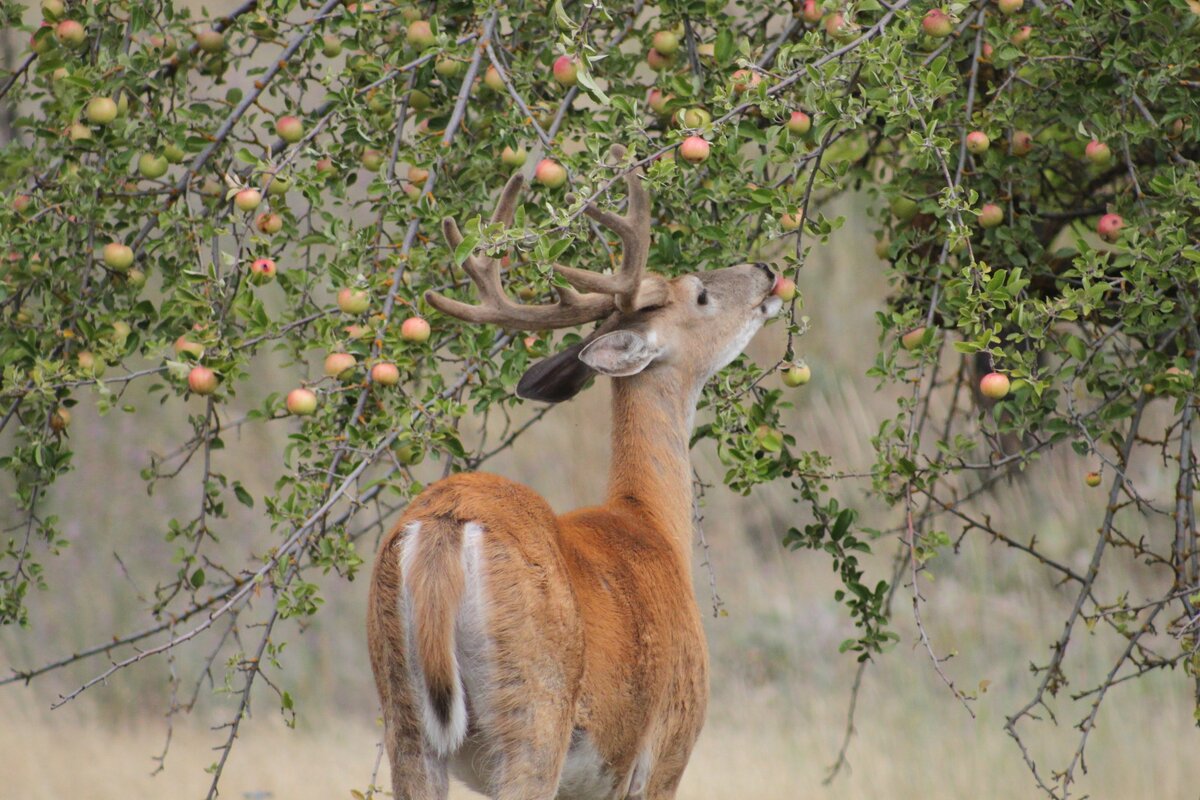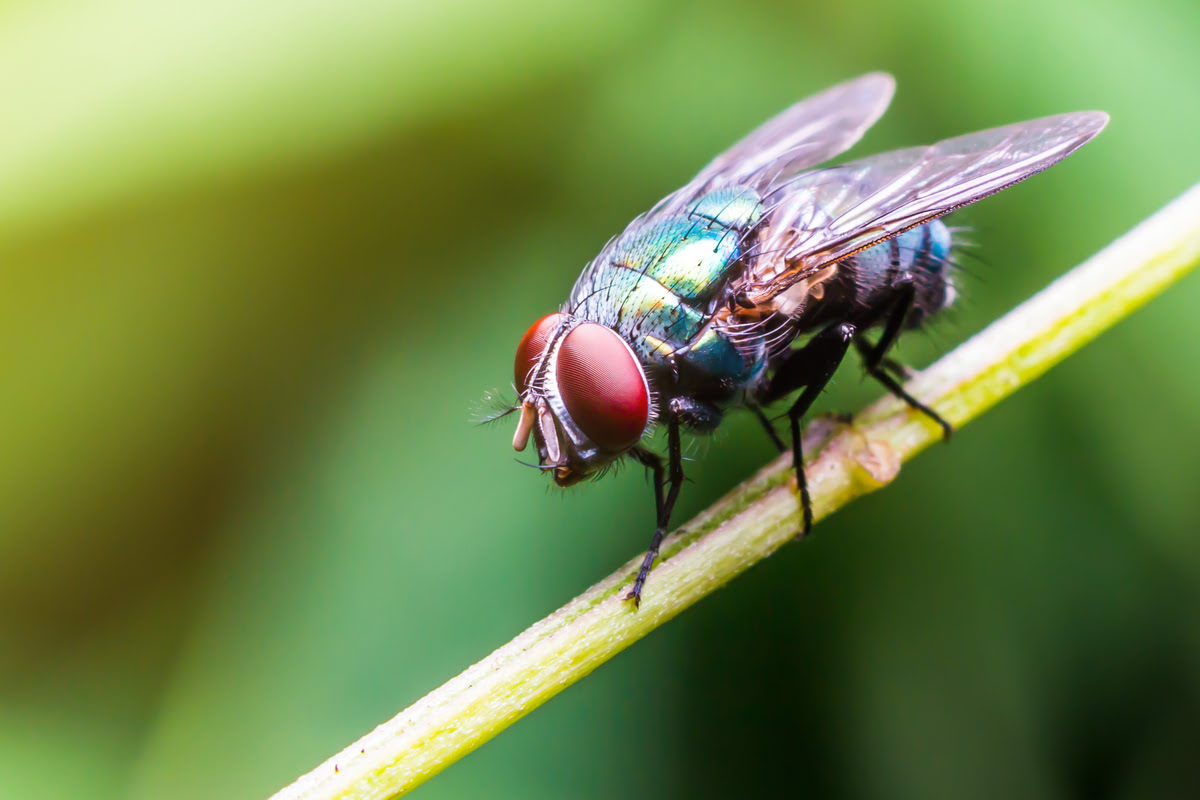Home>Gardening News and Trends>Latest News>How Can You Protect Yourself From Biological Hazards Associated With Animals And Insects


Latest News
How Can You Protect Yourself From Biological Hazards Associated With Animals And Insects
Modified: January 22, 2024
Stay updated with the latest news on protecting yourself from biological hazards associated with animals and insects. Learn valuable tips and precautions to keep yourself safe.
(Many of the links in this article redirect to a specific reviewed product. Your purchase of these products through affiliate links helps to generate commission for Chicagolandgardening.com, at no extra cost. Learn more)
Table of Contents
- Introduction
- Understanding Biological Hazards Associated with Animals and Insects
- Identifying Common Biological Hazards from Animals and Insects
- Preventive Measures to Protect Yourself from Biological Hazards
- Proper Handling and Disposal of Animal and Insect Waste
- Personal Protective Equipment for Safeguarding Against Biological Hazards
- Vaccinations and Immunizations for Protection against Animal and Insect-borne Diseases
- First Aid and Treatment Options for Biological Hazards
- Educating Yourself and Others on Biological Hazards from Animals and Insects
- Conclusion
Introduction
Welcome to our comprehensive guide on protecting yourself from biological hazards associated with animals and insects. As we navigate through our environment, we often come into contact with various types of creatures that can pose health risks. From household pets to outdoor wildlife, and from buzzing insects to crawling pests, it is important to be aware of the potential dangers they can bring. By understanding and taking preventive measures, you can safeguard yourself and your loved ones from these biological hazards.
Animals and insects can carry bacteria, viruses, parasites, and other pathogens that can cause diseases in humans. The transmission can occur through direct contact, bites, scratches, ingestion of contaminated food or water, or even through the air in some cases. These biological hazards can lead to a range of health issues, ranging from mild illnesses to severe infections and even life-threatening conditions.
In this guide, we will explore how to identify common biological hazards associated with animals and insects and provide you with practical tips on how to protect yourself. We will discuss preventive measures such as proper waste handling and disposal, the use of personal protective equipment, vaccinations and immunizations, as well as first aid and treatment options. Additionally, we will emphasize the importance of educating yourself and raising awareness among others about these potential hazards.
By following the information presented in this guide, you can minimize the risks associated with biological hazards from animals and insects. Remember, prevention is key when it comes to protecting yourself and your family’s well-being. Let’s dive into the world of biological hazards and learn how to stay safe in the face of these potential dangers.
Understanding Biological Hazards Associated with Animals and Insects
Before diving into preventive measures, it is crucial to understand the nature of biological hazards associated with animals and insects. These hazards arise from the potential transmission of pathogens that these creatures may carry. It is important to note that not all animals and insects are hazardous, but there are certain species that pose a greater risk to human health.
Animals such as rodents, bats, birds, and reptiles can carry various diseases. For example, rodents can transmit diseases like hantavirus through their urine, droppings, or saliva. Bats are known carriers of the rabies virus, which can be transmitted through bites or scratches. Birds can carry avian influenza viruses, and reptiles, such as turtles and lizards, can transmit salmonella.
When it comes to insects, mosquitoes are well-known carriers of diseases such as malaria, dengue fever, and Zika virus. Ticks can transmit Lyme disease, while fleas can spread diseases like the bubonic plague. Additionally, certain types of flies and cockroaches can contaminate food and surfaces, leading to foodborne illnesses.
It is essential to understand the routes of transmission for these biological hazards. Direct contact with animals or insect bites are common modes of transmission. In some cases, airborne transmission can occur, particularly with diseases carried by birds or certain insects. Another important factor to consider is the role of contaminated waste, including feces and urine, which can pose a significant risk if not handled properly.
By understanding the potential biological hazards associated with animals and insects, you can take the necessary precautions to minimize your risk of exposure. In the following sections, we will delve into specific preventive measures that will help protect you from these hazards. Remember, knowledge is power, and being aware of the risks is the first step towards safeguarding your well-being.
Identifying Common Biological Hazards from Animals and Insects
Identifying common biological hazards from animals and insects is crucial in order to effectively protect yourself and take appropriate preventive measures. By recognizing the potential risks associated with certain species or environments, you can proactively reduce your chances of exposure to harmful pathogens.
One common biological hazard is zoonotic diseases, which are diseases that can be transmitted between animals and humans. These diseases can be caused by bacteria, viruses, parasites, or fungi. Some examples of zoonotic diseases include rabies, Lyme disease, West Nile virus, and salmonellosis.
When it comes to animals, certain characteristics can indicate potential hazards. For instance, animals that exhibit aggressive behavior or appear disoriented may be carrying diseases such as rabies. Rodents, especially rats and mice, can transmit diseases through their droppings, urine, and saliva. Be cautious around wild or stray animals, as they can carry diseases that can be transmitted through bites or scratches.
Insects also pose a significant risk when it comes to biological hazards. Mosquitoes are a common carrier of diseases such as malaria, dengue fever, and Zika virus. Ticks can transmit Lyme disease, while fleas can spread the bubonic plague. Be cautious when spending time in outdoor environments where these insects are prevalent, and take steps to protect yourself from bites.
It is also important to recognize the signs of potential hazards in the environment. For example, areas with stagnant water are breeding grounds for mosquitoes, increasing the risk of mosquito-borne diseases. Pay attention to the presence of insect nests or infestations around your home, as this can indicate an elevated risk of exposure to biological hazards.
Educating yourself about the common biological hazards associated with animals and insects can empower you to make informed decisions and take proactive measures to reduce your risk. By staying alert and aware of your surroundings, you can effectively identify potential hazards and take the necessary steps to protect yourself and your loved ones.
Preventive Measures to Protect Yourself from Biological Hazards
When it comes to protecting yourself from biological hazards associated with animals and insects, prevention is key. By taking proactive measures, you can significantly reduce the risk of exposure to harmful pathogens and ensure your well-being. Here are some important preventive measures to consider:
- Maintain good hygiene: Practicing good personal hygiene is essential in preventing the spread of diseases. Wash your hands thoroughly with soap and water after handling animals, cleaning up animal waste, or being in outdoor environments where you may have come into contact with insects. Use hand sanitizers when soap and water are not available.
- Use insect repellents: Protect yourself from insect bites by using insect repellents containing DEET or picaridin. Apply them to exposed skin and clothing when spending time outdoors, especially in areas known for insect-borne diseases. Follow the instructions on the product label and reapply as necessary.
- Keep animals and pets healthy: Regular veterinary care, including vaccinations and preventive treatments, is important to ensure the health of your pets. By keeping your pets healthy, you reduce the risk of them carrying and transmitting diseases to you and your family.
- Avoid direct contact with wild or stray animals: Wild or stray animals may carry diseases that can be transmitted through bites or scratches. Avoid approaching or handling these animals, and teach children to do the same. If you encounter injured or sick wildlife, contact local authorities or animal control for assistance.
- Protect yourself in outdoor environments: When spending time in areas where biological hazards may be present, such as forests or fields, wear appropriate clothing to minimize skin exposure. Tuck your pants into your socks and wear long-sleeved shirts. Consider using mosquito nets, especially when sleeping in outdoor or heavily infested areas.
- Keep your living environment clean: Regularly clean and disinfect areas where animals reside, such as pet litter boxes, cages, and bedding. Dispose of animal waste properly, following local regulations and guidelines. Maintain good sanitation practices to reduce the risk of disease transmission from animals or insects.
By implementing these preventive measures, you can significantly reduce the likelihood of encountering biological hazards from animals and insects. Remember, prevention is always better than cure when it comes to safeguarding your health and well-being.
Proper Handling and Disposal of Animal and Insect Waste
The proper handling and disposal of animal and insect waste is crucial in preventing the spread of diseases and minimizing the risk of exposure to biological hazards. Waste from animals and insects can contain harmful pathogens that can lead to infections and illnesses if not handled correctly. Here are some important guidelines to follow:
- Wear protective gear: When handling animal waste, especially from wild or unfamiliar animals, it is important to wear gloves, masks, and other appropriate protective gear. This will help protect you from direct contact with potentially contaminated waste.
- Use designated waste disposal containers: Have separate containers specifically designated for the disposal of animal waste. These containers should be tightly sealed to prevent any leakage or contamination. Follow local regulations and guidelines for the proper disposal of animal waste.
- Properly clean and disinfect: Clean any areas or surfaces that may have come into contact with animal or insect waste. Use appropriate cleaning agents and disinfectants to ensure thorough cleaning and to eliminate any potential pathogens.
- Dispose of pet waste properly: If you have pets, ensure that their waste is disposed of properly. Use poop bags or scoopers to pick up pet waste and dispose of it in designated waste bins or in compliance with local regulations. Avoid throwing pet waste in regular trash cans or flushing it down the toilet.
- Manage pest infestations: In the case of insect waste, such as remnants of nests or excrement, take steps to manage and remove any infestations. Consult with pest control professionals to identify the best course of action for safe and effective removal.
- Regularly clean and maintain waste areas: If you have outdoor areas where animals or insects are likely to frequent, such as a backyard or garden, regularly clean and maintain these areas. Remove any accumulations of waste or debris that may attract pests or contribute to the spread of diseases.
By following these guidelines, you can minimize the risk of exposure to biological hazards present in animal and insect waste. Proper handling and disposal of waste are essential in maintaining a safe and healthy environment for yourself and those around you.
Personal Protective Equipment for Safeguarding Against Biological Hazards
Personal protective equipment (PPE) plays a critical role in safeguarding against biological hazards associated with animals and insects. PPE is designed to provide a physical barrier between you and potential pathogens, reducing the risk of exposure and infection. Here are some key PPE items to consider when dealing with biological hazards:
- Gloves: Disposable gloves are essential for protecting your hands when handling animals, cleaning animal waste, or coming into contact with insects. Make sure to choose gloves that are appropriate for the task and dispose of them properly after use.
- Masks: Depending on the situation and the potential for airborne transmission, wearing masks can provide protection against inhaling harmful particles. Masks can be particularly important when dealing with animal waste that may release dust or respiratory droplets.
- Goggles or face shields: If there is a risk of splashing or spray of bodily fluids or animal waste, wearing goggles or face shields can protect your eyes and face from potential contamination.
- Coveralls or protective clothing: In situations where there is a higher risk of direct contact with animal waste or insects, consider wearing coveralls or dedicated protective clothing. These provide full-body protection and can be disposed of or properly cleaned after use.
- Footwear: Choose appropriate footwear that covers your feet and is easy to clean, especially when working in areas where animal waste or insects may be present. Boots or closed-toe shoes with slip-resistant soles are recommended.
- Insect repellent clothing: When spending time in areas prone to insect-borne diseases, consider wearing clothing that has been treated with insect repellent. This provides an additional layer of protection against insect bites.
It is important to note that proper usage, maintenance, and disposal of PPE are essential to ensure its effectiveness. Always follow the manufacturer’s instructions and guidelines when using PPE, and dispose of it properly after each use.
While PPE is a valuable tool in protection against biological hazards, it should be used in conjunction with other preventive measures such as good hygiene practices, environmental cleanliness, and proper waste disposal. By incorporating appropriate PPE into your safety routines, you can enhance your protection and reduce the risk of exposure to biological hazards.
Vaccinations and Immunizations for Protection against Animal and Insect-borne Diseases
Vaccinations and immunizations are essential in protecting against animal and insect-borne diseases. These preventive measures help strengthen the immune system and provide immunity against specific pathogens that animals and insects may carry. By staying up to date with vaccinations and immunizations, you can significantly reduce the risk of contracting serious illnesses. Here are some key points to consider:
Vaccinations for animals: If you have pets, it is important to ensure that they receive proper vaccinations. Common vaccinations for pets include rabies, distemper, parvovirus, and leptospirosis. Vaccinating your pets not only protects their health but also reduces the risk of transmission of these diseases to humans.
Vaccinations for humans: Depending on the geographical location and specific risks, certain vaccinations may be recommended or required. Examples include vaccines for diseases like rabies, Lyme disease, dengue fever, and Japanese encephalitis. In some cases, booster shots may be necessary to maintain immunity levels.
Travel vaccines: If you are traveling to areas with known animal or insect-borne diseases, consult with a healthcare professional or travel medicine specialist to determine the appropriate vaccines for your destination. Diseases such as yellow fever, malaria, or typhoid may require specific vaccinations or preventive medications.
Timely immunizations: Make sure that you and your family are up to date with routine immunizations recommended by healthcare authorities. This includes vaccinations for diseases like tetanus, mumps, measles, rubella, and hepatitis. By maintaining a strong immune system and protecting against common diseases, you are better equipped to handle potential infections from animal or insect-borne diseases.
Consultation with healthcare professionals: Reach out to healthcare professionals, such as doctors or veterinarians, for guidance on the most appropriate vaccinations and immunizations for you and your pets. They can provide personalized recommendations based on your specific health conditions, travel plans, and potential risks in your area.
Stay informed: Stay updated with the latest information on animal and insect-borne diseases. Follow guidance from reliable sources such as the World Health Organization (WHO) or the Centers for Disease Control and Prevention (CDC). By staying informed, you can make informed decisions about vaccinations and immunizations for yourself and your pets.
Vaccinations and immunizations are powerful tools in protecting against animal and insect-borne diseases. By taking these preventive measures, you can not only safeguard your own health but also contribute to the overall prevention and control of these diseases.
First Aid and Treatment Options for Biological Hazards
Knowing proper first aid and treatment options is essential when dealing with biological hazards associated with animals and insects. Prompt and appropriate action can help minimize the impact of exposure to harmful pathogens and prevent further complications. Here are important measures to consider in case of potential infections:
Clean the affected area: If you experience a bite, scratch, or contact with animal waste, it is important to clean the affected area thoroughly with soap and warm water. This helps remove any potential pathogens on the surface of the skin and reduces the risk of infection.
Apply first aid techniques: For minor wounds, such as small cuts or scratches, apply an appropriate antiseptic solution or ointment to prevent infection. Cover the wound with a sterile bandage or dressing to protect it from further contamination.
Seek medical attention: If you are bitten or scratched by an animal or if you develop flu-like symptoms after exposure to animals or insects, seek medical attention promptly. Describe the situation to healthcare professionals, providing details of the incident or exposure for accurate diagnosis and appropriate treatment.
Follow medical advice and treatment: Follow the medical advice given by healthcare professionals regarding the management of any potential infections. Depending on the situation, treatment may include antibiotics, antiviral medications, or specific medical interventions based on the identified disease or pathogen.
Monitor for symptoms: Stay vigilant for any signs of illness or infection following exposure to biological hazards. Common symptoms may include fever, headache, muscle aches, nausea, vomiting, or rash. If you experience any unusual symptoms, contact your healthcare provider for further evaluation and guidance.
Adhere to prescribed medications: If medication is prescribed, such as antibiotics or antiviral drugs, it is crucial to complete the full course as directed by healthcare professionals. This helps ensure the eradication of the infection and reduces the risk of relapse or the development of antibiotic resistance.
Prevent further exposure: While receiving treatment, taking preventive measures to minimize further exposure to animals or insects is important. This may involve avoiding contact with animals, implementing mosquito control measures, or practicing good hygiene to reduce the risk of spreading the infection to others.
Remember, proper first aid and timely medical assistance can make a significant difference in the outcome of an infection or illness caused by biological hazards. By staying informed and taking appropriate actions, you can protect yourself and others from potential complications and promote a faster recovery.
Educating Yourself and Others on Biological Hazards from Animals and Insects
Educating yourself and others on biological hazards from animals and insects is crucial in raising awareness and promoting proactive measures to prevent the spread of diseases. By learning about potential risks, sharing information, and implementing preventive strategies, you can contribute to the well-being of your community and protect yourself and others. Here are some key points to consider:
Stay informed: Keep yourself updated on the latest research, guidelines, and information related to animal and insect-borne diseases. Follow reputable sources such as health organizations, government agencies, and scientific journals. Being informed allows you to make well-informed decisions and better protect yourself and your community.
Share knowledge: Educate your family, friends, and community members about the potential biological hazards associated with animals and insects. This can be done through conversations, social media, or community events. Raise awareness about the importance of preventive measures, such as vaccinations, proper waste disposal, and personal hygiene.
Offer practical tips: Provide practical tips on how to minimize the risk of exposure to biological hazards. Share information on wearing appropriate clothing, using insect repellents, maintaining cleanliness in living environments, and avoiding direct contact with wild or unfamiliar animals.
Involve schools and educational institutions: Collaborate with schools and educational institutions to incorporate lessons and workshops on biological hazards into the curriculum. Foster a culture of health and safety by promoting awareness and preventive practices among students and staff.
Engage pet owners: Reach out to pet owners in your community and inform them about the importance of vaccinations for their pets. Encourage responsible pet ownership and emphasize the role of pets in disease transmission. Share information on local veterinary services and resources for vaccinations and preventive treatments.
Participate in community initiatives: Get involved in community initiatives focused on public health and safety. Join local awareness campaigns, volunteer for organizations working to prevent animal and insect-borne diseases, or participate in events that promote education and prevention in your community.
Be a role model: Lead by example and demonstrate responsible behavior when it comes to dealing with animals and insects. Follow proper waste disposal practices, maintain good hygiene, and take necessary precautions to protect yourself. By modeling these behaviors, you inspire others to do the same.
Continuous learning: Keep updating your knowledge on biological hazards from animals and insects. Stay informed about emerging diseases, new preventive measures, and advancements in treatment options. This allows you to adapt and share accurate and relevant information with others.
By educating yourself and others on biological hazards from animals and insects, you can foster a culture of awareness, preparedness, and preventive action. Together, we can minimize the impact of these hazards and create safer environments for ourselves, our communities, and our ecosystems.
Conclusion
Protecting yourself from biological hazards associated with animals and insects is crucial for maintaining your health and well-being. By understanding the risks, recognizing common hazards, and taking proactive measures, you can reduce the chances of exposure to harmful pathogens and prevent the spread of diseases.
In this comprehensive guide, we have explored various aspects of protecting against biological hazards. We discussed the importance of understanding and identifying potential risks, as well as the significance of proper waste disposal and personal protective equipment. We also highlighted the role of vaccinations, first aid, and education in minimizing the impact of biological hazards.
Remember, knowledge is power. Stay informed about the latest research, guidelines, and recommendations related to animal and insect-borne diseases. Share this knowledge with others, including your family, friends, and community members, to raise awareness and promote responsible behavior.
By implementing preventive measures, such as practicing good hygiene, using insect repellents, and following proper waste disposal protocols, you can significantly reduce the risk of exposure. Regular veterinary care and vaccinations for your pets are also essential in preventing the transmission of diseases from animals to humans.
In case of potential infections, prompt first aid and seeking medical attention are crucial. Follow the advice and treatment prescribed by healthcare professionals to ensure proper care and recovery.
Educating yourself and others is an ongoing process. Stay updated on emerging diseases, engage in community initiatives, and be a role model by practicing responsible behavior. By taking these steps, you contribute not only to your own well-being but also to the health and safety of your community.
Remember, prevention is key. By adopting the preventive measures outlined in this guide and remaining vigilant, you can protect yourself and mitigate the risks associated with biological hazards from animals and insects.










